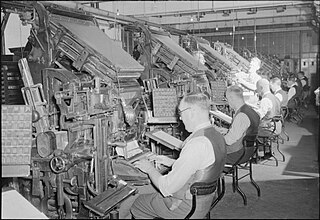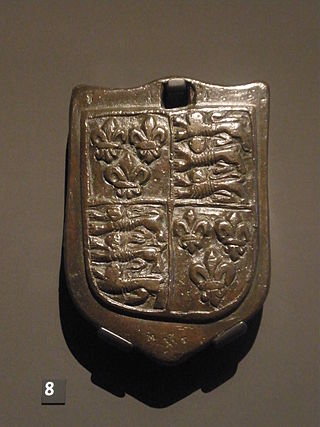Related Research Articles

The history of British newspapers begins in the 17th century with the emergence of regular publications covering news and gossip. The relaxation of government censorship in the late 17th century led to a rise in publications, which in turn led to an increase in regulation throughout the 18th century. The Times began publication in 1785 and became the leading newspaper of the early 19th century, before the lifting of taxes on newspapers and technological innovations led to a boom in newspaper publishing in the late 19th century. Mass education and increasing affluence led to new papers such as the Daily Mail emerging at the end of the 19th century, aimed at lower middle-class readers.

Oliver Goldsmith was a well-known Anglo-Irish novelist, playwright, dramatist and poet, noted for his novel The Vicar of Wakefield (1766), his pastoral poem The Deserted Village (1770), and his plays The Good-Natur'd Man (1768) and She Stoops to Conquer. He is thought by some to have written the classic children's tale The History of Little Goody Two-Shoes (1765).
This article contains information about the literary events and publications of 1844.

William Coxe was an English historian and priest who served as a travelling companion and tutor to nobility from 1771 to 1786. He wrote numerous historical works and travel chronicles. Ordained a deacon in 1771, he served as a rector and then archdeacon of Bemerton near Salisbury from 1786 until his death.

John Perceval, 2nd Earl of Egmont was a British politician, political pamphleteer, and genealogist who served as First Lord of the Admiralty. Of Anglo-Irish background, he sat in both the Irish and British Parliaments. He was the father of the Regency Era Prime Minister Spencer Perceval.

The Vicar of Wakefield, subtitled A Tale, Supposed to be written by Himself, is a novel by Anglo-Irish writer Oliver Goldsmith (1728–1774). It was written from 1761 to 1762 and published in 1766. It was one of the most popular and widely read 18th-century novels among Victorians.

The stone or stone weight is an English and British imperial unit of mass equal to 14 pounds (6.35 kg). The stone continues in customary use in the United Kingdom and Ireland for body weight.
Hugh Kelly was an Irish dramatist and poet. From the 1760s he was employed as a propagandist for the British government, attacking members of the Opposition. After arriving in London in 1760 to work as a staymaker, he soon turned to become a writer and made a living as a journalist. In 1766 he published Thespis, a long poem about the acting profession, which gained him wide attention. He followed up this success with the novel Memoirs of a Magdalen in 1767. He ultimately became known for his stage plays such as False Delicacy and A Word to the Wise.
The McClatchy Company, or simply McClatchy, is an American publishing company incorporated under Delaware's General Corporation Law. Originally based in Sacramento, California, U.S., the publication became a subsidiary of Chatham Asset Management, headquartered in Chatham Borough, New Jersey as a result of its 2020 bankruptcy. The publication operates 29 daily newspapers in fourteen states and has an average weekday circulation of 1.6 million and Sunday circulation of 2.4 million. In 2006, it purchased Knight Ridder, which at the time was the second-largest newspaper company in the United States. In addition to its daily newspapers, McClatchy also operates several websites and community papers, as well as a news agency, McClatchy DC Bureau, focused on political news from Washington, D.C.
William Newmarch was an English banker, economist and statistician.

John Baker Holroyd, 1st Earl of Sheffield, was an English politician and soldier. He was a leading authority on agriculture and commerce and appointed President of the Board of Agriculture in 1803. He is also remembered as the close friend and patron of eminent historian Edward Gibbon, to whom he acted as literary executor and editor.

John Carr (1723–1807) was a prolific English architect, best known for Buxton Crescent in Derbyshire and Harewood House in West Yorkshire. Much of his work was in the Palladian style. In his day he was considered to be the leading architect in the north of England.
The Morning Chronicle was a newspaper founded in 1769 in London. It was notable for having been the first steady employer of essayist William Hazlitt as a political reporter and the first steady employer of Charles Dickens as a journalist. It was the first newspaper to employ a salaried woman journalist Eliza Lynn Linton; for publishing the articles by Henry Mayhew that were collected and published in book format in 1851 as London Labour and the London Poor; and for publishing other major writers, such as John Stuart Mill.

William Robert FitzGerald, 2nd Duke of Leinster, KP, PC (Ire) was an Irish liberal politician and landowner. He was born in London.

The Reverend William Jackson was a noted Irish preacher, journalist, playwright, and radical. He served first as a preacher and private chaplain of the Church of England before moving into journalism, writing for several newspapers in London across both sides of the political aisle.

The i is a British national newspaper published in London by Daily Mail and General Trust and distributed across the United Kingdom. It is aimed at "readers and lapsed readers" of all ages and commuters with limited time, and was originally launched in 2010 as a sister paper to The Independent. It was later acquired by Johnston Press in 2016 after The Independent shifted to a digital-only model. The i came under the control of JPIMedia a day after Johnston Press filed for administration on 16 November 2018. The paper and its website were bought by the Daily Mail and General Trust (DMGT) on 29 November 2019, for £49.6 million. On 6 December 2019 the Competition and Markets Authority served an initial enforcement order on DMGT and DMG Media Limited, requiring the paper to be run separately pending investigation.
The Times was a daily newspaper published from March 13, 1875, to August 11, 1902, in Philadelphia, Pennsylvania.
Crow Street Theatre was a theatre in Dublin, Ireland, originally opened in 1758 by the actor Spranger Barry. From 1788 until 1818 it was a patent theatre.
Charlotte Forman (1715–1787) was a British journalist, translator, political essayist and activist. Between 1756 and 1780, she wrote political essays and news from abroad for many newspapers under various pseudonyms, most notably Probus. Unknown in her lifetime, in more recent years Forman's career has garnered significance as she was one of the few women of the period who wrote essays on what were considered masculine subjects.
References
- 1 2 Rose, Jonathan. "John Newbery", The British Literary Book Trade, 1700–1820. Eds. J. K. Bracken and J. Silver. Dictionary of Literary Biography. Vol. 154. 1995.
- ↑ Lucyle Werkmeister, The London Daily Press, 1772–1792, University of Nebraska Press, 1963.
- ↑ "The Public Ledger".
- ↑ Staves, Susan (23 September 2004). "Forman, Charlotte [pseud. Probus] (1715–1787), journalist and translator" . Oxford Dictionary of National Biography (online ed.). Oxford University Press. doi:10.1093/ref:odnb/72232. ISBN 978-0-19-861412-8 . Retrieved 5 July 2020.(Subscription or UK public library membership required.)
- ↑ Sage, Lorna; Greer, Germaine; Showalter, Elaine (30 September 1999). The Cambridge Guide to Women's Writing in English. Cambridge University Press. p. 249. ISBN 9780521668132.
- ↑ "The Public Ledger". IEG Vu. Retrieved 29 November 2019.
- ↑ The Vicar of Wakefield, ISBN 0-19-283940-3